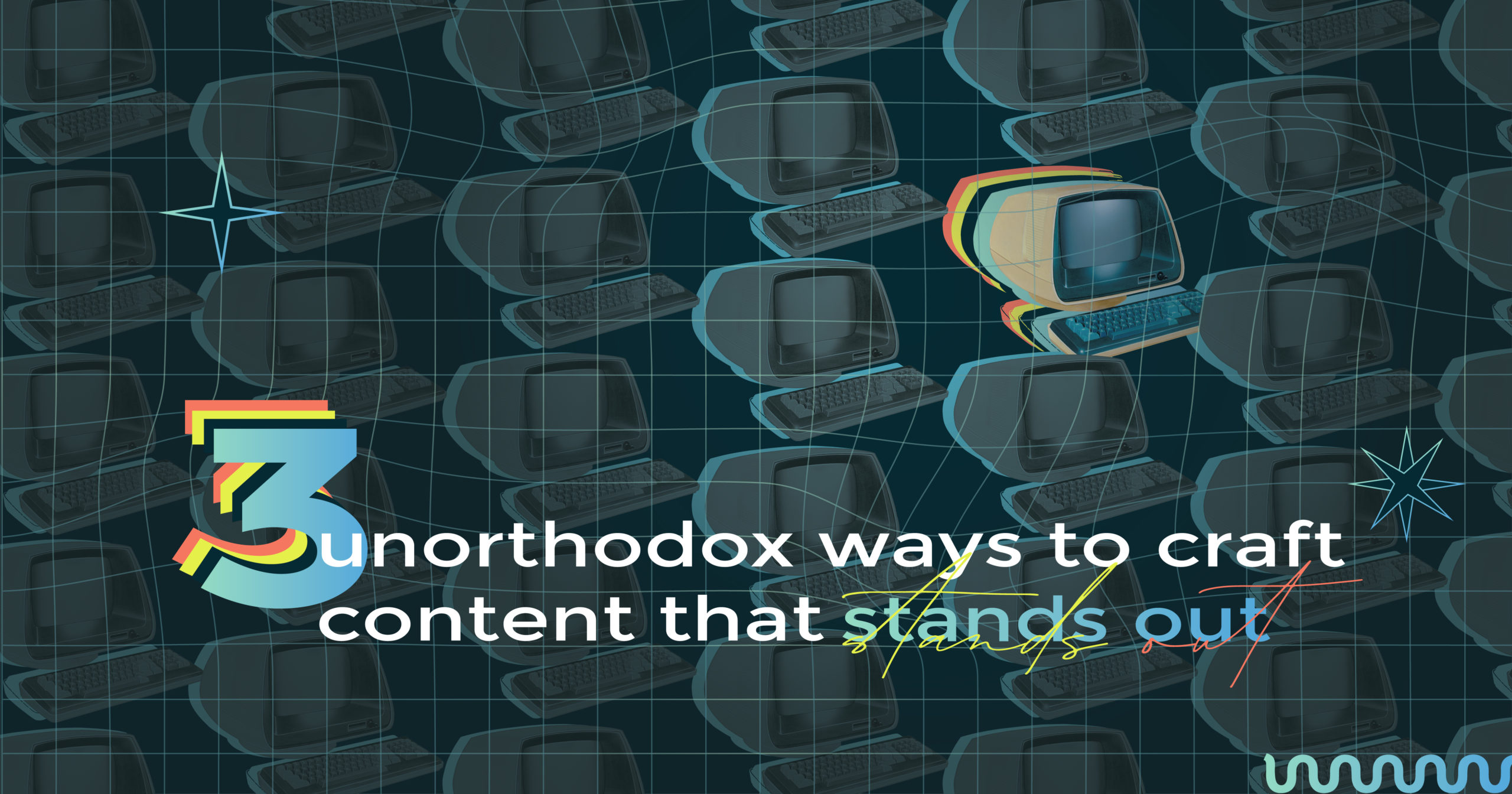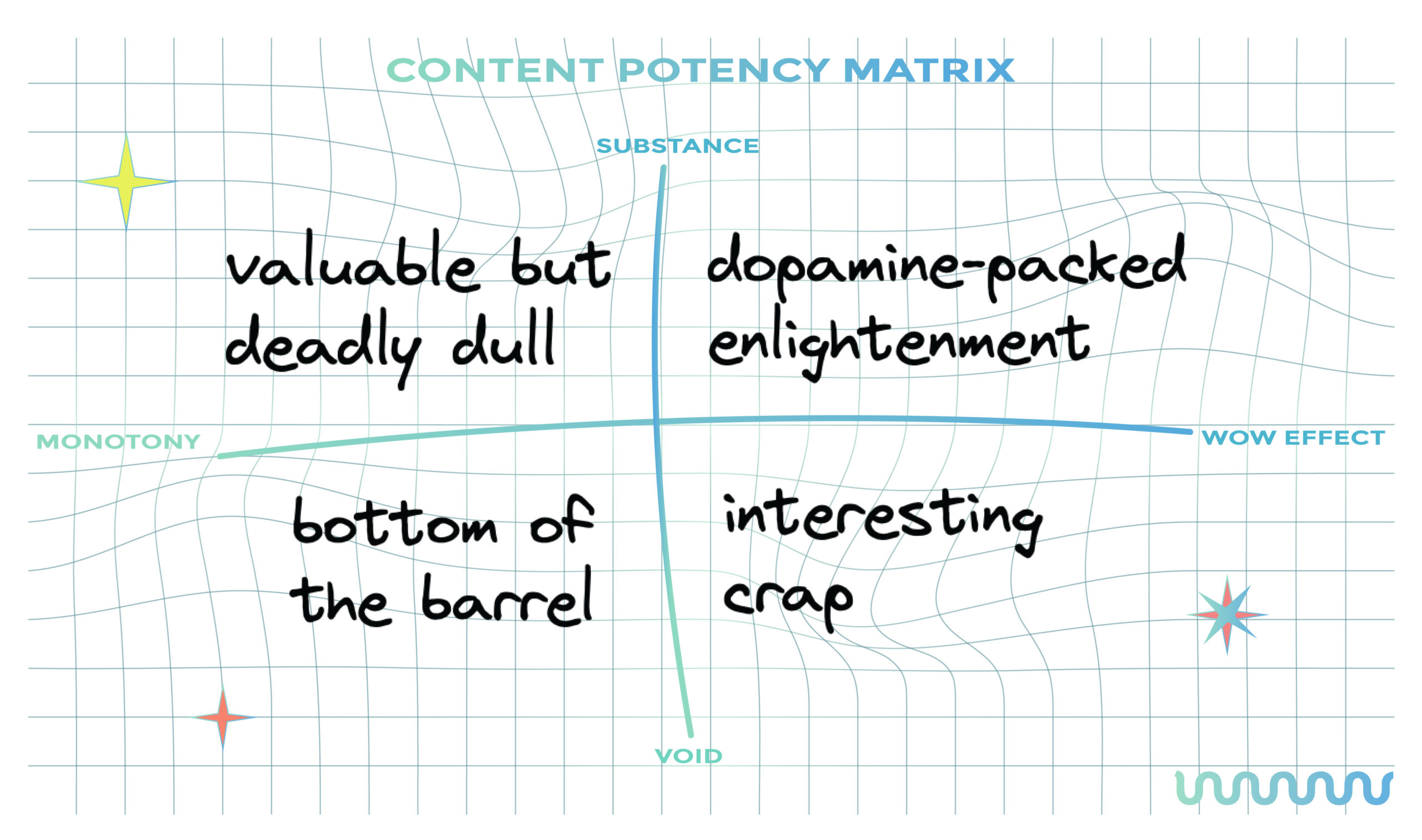
3 Unorthodox Ways to Craft Content that Stands Out
Congratulations, you’ve just published your new fabulous, heavyweight, SEO-driven blog post about the topic you have been mastering for years. Or let’s say, congratulations, you just threw a snowflake into the avalanche of lookalike content.
A disappointment like this raises a million-dollar question: How to get noticed when literally every company is pushing the pedal on content marketing harder and harder?
How to come to the situation in which a potential customer, while reading your e-book, says: “Hm, I never thought this way,” or “Whoa… this completely changes my perspective, ” or at least “Hahahahah, these guys are hilarious.” How do you achieve that instant WOW effect?
In-depth strategy? Producing more content? Throwing another $10,000 at paid ads?
Sure, it may help. But for how long?
Even though content marketing is a long game that helps you build trust incrementally, you still need that WOW effect. But why?
First and foremost, it sticks. When we experience the WOW effect, we’re high on dopamine. And because of the dopamine rush, the effect stays in our system much longer, and it is easier to retrieve it from memory. Simply put, the WOW effect is a Bohemian Rhapsody in a bunch of cloned strophe-refrain-strophe-refrain songs – it touches the highest point of people’s consciousness.
An average B2B company consumes 13 pieces of content about a product/service before they decide to make a purchase. That’s a customer odyssey, not a journey.
And what is worse, today’s 13 steps will turn into 22 tomorrow. And the day after tomorrow, you will have to create 36 content pieces to get a customer.
With content saturation growing, the point at which the investment starts to pay off will be even further.
That is why having WOW effect on your readers is essential. It is an unavoidable step in running away from the matrix and the most promising chance for shortening the cycle.

Reframing a basic block of content marketing
One path to escape the content swamp is to get back to basics and strengthen the foundation of content marketing — a piece of content.
Consider thought leadership — a radically different approach when it comes to business writing lately. It is a tactical form of content that provides hyper-value based on the author’s credibility, insights, and inimitable views regarding the topic. With that being said, relying on this quality-packed form of writing improves the likelihood of triggering the WOW effect.
Linkedin suggests in their study that consumption of thought leadership content rises during the pandemic. As a result, decision-makers spend more than an hour researching and reading thought leadership content. On the flip side 71% of C-suite people claimed that more than 50% of thought leadership content provided unsatisfactory insights.
Once something becomes mainstream, you can bet that its quality will be watered down.
So, what should you do to prevent your content from going into a downward spiral?
Here are a few controversial but worth-trying examples of how to stand out from the crowd by boosting content potency.
1. Being negative (when required) is not a sin
The business ecosystem on the surface: Unicorns are jumping around and shooting rainbows out of their asses. Squirrels are giggling while using the rainbows as toboggans. Bright, psychedelic colors and the smell of an appealing, sticky punch is everywhere. The atmosphere of a hippie commune — the tsunami of love, respect, and positive energy. Everything is frictionless.
One of the most accepted narratives in business is to be positive at any cost.
Focus on yourself, don’t bother with what others do, always talk politely about competition, choose words, filter emotions, speak like a machine. Just keep the peace for the sake of everyone’s prosperity.
This is called toxic positivity. When untreated, it induces implosions. And implosions are vicious.
Optimism is — no question — beneficial. But it can’t diminish real problems. A problem may be “a challenge” for someone but let’s not pretend challenges can’t cause nightmares. Likewise, negative emotions will not disappear after you recline in your expensive ergonomic chair. Such feelings are caused by hostile managers, fake company culture, useless products, and unfair competition.
All things considered, many companies do hideous things, and we become a sort of accomplice in their misdeeds by choosing to remain silent.
Ok, but why would anyone write about it in a company blog post? These topics should be addressed in internal meetings or psychotherapy sessions, right?
The point is — occasional channeling of these frustrations we encounter almost daily can be highly beneficial for both professionals and their companies.
From time to time, just give a shot at the topics like these:
- We made a disgusting product. Here’s what we learned from that disaster.
- Q3 2021 — a short horror story.
The companies that buy our competitor’s product will soon regret it. Here’s why. - Meet the people: Stephen, our lead engineer, who struggled with depression for three years.
- We had a psychopath in our team for years — here’s how to recognize them.
- Hey, <insert the name of the main competitor>, screw you (and your eyebrows)!
Nobody will skim this content. It will be read in detail. It will be shared. Why?
Because:
- it breaks the content matrix
- it is authentic to the bone
- it is valuable and relatable
People feel at ease when they see that someone else shares their anger or frustration. When everything is not ideal. It is closer to the real world. So why would business be different?
2. Humor isn't an option
:drum rolls:
Humor is a must. But not exclusively on social networks where everyone is laid back. People want laughs in a case study. They want it in a white paper that explains the technical aspects of the latest technology through a rainforest of cumbersome information.
Humor when a buyer has to decide whether to invest a tremendous amount of money? It seems counterintuitive.
In fact, people want humor even when they don’t know they want it.
Humor is inherent in each of us and is one of our most profound coping mechanisms. For example, people laugh at funerals, not because they are rude, but because they are scared. Humor softens fear, and deciding whether to invest vast amounts of money in some service is nothing else but fear of the unknown.
Hot take: If your CTA costs money, humor should be subtle. The golden rule is more money = more subtlety.
Benefits from adding humor to your content:
- Shows humanity
- Builds empathy
- Spreads joy
- Helps others identify with people and ideas
- Removes FUD
- Improves connections with others
- Makes reading digestible
To prove its quality, every wanna-be-good article about something must provide genuine examples of why and how “something” works. This one isn’t an exception. But instead of showing “how to,” let’s do the opposite.
Memes are peaking. Nevertheless, we are obsessed with them. They are funny, relaxing, and immersive. Addictive, so to speak. However, just be careful with them.
Monday: A creative person makes some ROFLMAO meme, which is massively shared across social networks.
Tuesday: The meme is at the peak of its existence. In the afternoon, boomers share it in their Viber groups.
Wednesday: Paris Hilton uses the meme.
Thursday: Not a living soul uses the meme anymore.
Friday: Companies start to exploit the meme.
Humor tends to be a bandwagon. Humor is widely replicated because everyone wants to be perceived as funny. Being funny means being recognized and accepted. But misusing wittiness is irritating and counterproductive. Your humor is outdated. There are no more perishable goods than memes nowadays.
High-quality humor isn’t simple. But neither is quality pottery. Neither is making superb software. The point is you must rely on authenticity in your wit. And the most important of all — dose humor carefully; companies are not stand-up comedians.
3. Have fun with structure. Disobey "the laws."
Cormac McCarthy wrote The Road using almost no punctuation. Just a long string of words without pause. But people loved it and read it massively. As a result, 1,385,000 copies of the book have been sold.
Julio Cortásar’s book Hopscotch is another fascinating example. You can read it linearly, but you can also read it by skipping specific chapters. Or entirely at random. And it’s excellent no matter which way you read it.
Should you write a white paper without punctuation? Or a case study backward? Probably not because these are not intended to be contemplative fiction, but as long as you don’t sacrifice clarity, you are free to play with content the way you want. The whole point is to explore what lies beyond the construction of traditional marketing copy and how it may spark a fire in a reader’s eye.
If compelling storytelling could improve sales, it should be used in all forms and angles.
Hint:

Still Alice, Away from her, The Iron Lady, Emmerdale… An enormous list of films dealing with dementia and Alzheimer’s disease from various angles. Some of it dealt with the theme poorly, others better.
Then, in 2020, the incredible film Father turned things upside down. It portrayed the horrific condition from the sufferer’s perspective, creating mystery and horror and bringing the viewers directly into the protagonist’s shoes. A well-deserved Oscar for the adapted scenario.
No constitution or law in the world says a business idea must be presented only using acknowledged techniques.
It does not have to be written in the third person.
It doesn’t have to be written in the simple present tense.
Your product can be a storyteller.
Your product can be a protagonist.
…
Your content may become poetry if you want.
In an essay, The Reading Process – a Phenomenological Approach, Wolfgang Iser says that reading literary texts fosters an ability to ask questions and make connections.
“In the world of business, we look forward, we look back, we decide, we change our decisions, we form expectations, we are shocked by their non-fulfillment, we question, we use, we accept, we reject.”
(Iser, 1974).
We do the same when we read a poem and try to grasp its meaning. As a result, poetry causes more intense emotional states than prose and benefits our decision-making.
After all, business poetry does not have to be a Baudelaire-like quality. But it lets you think about a “poetic framework” that maximizes clarity by creating vivid images and cutting out all fluff. Isn’t the goal of content marketing to convey the message as quickly and clearly as possible?
Armies and strategies win wars, and yet, we celebrate individual heroes
Yes, the focus will and should always be on the macro picture. One exceptional blog post probably won’t beat 20 okay-ish, thoughtful, interlinked articles in the long run. Consistency always trumps occasional brilliance.
But it would be foolish to deploy all forces in one direction and overlook the benefit of being a marketing partisan.
Other than a strategic and exhaustive long-run battle, there are many minor clashes you may win every time you publish fresh, unorthodox content. These victories will ensure you get the attention you deserve.
And is there a more expensive resource than attention today?


